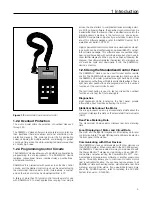
9
2 Installing the SAMMS-LV Device
2.4.2 Grounding the Device
As stated in Guideline 5, ground each motor controller at a
single ground point. The grounding path to earth must be
permanent and continuous. It must also be able to safely
conduct ground fault currents that may occur in the system to
ground through minimum impedance. The earth ground does
not carry any current under normal conditions.
Note:
Do not ground the SAMMS auxiliary current sensor (ACT)
leads. (See figure 2.1.)
Connect a ground bus to the chassis of each controller or to the
chassis of the mounting equipment containing the earth ground
through a grounding conductor.
Refer to Article 250 of the National Electrical Code for informa-
tion about the types and sizes of wire conductors and methods
for safely grounding electrical equipment and components.
2.4.3 Connecting the Device to a Control
Power Source
The SAMMS-LV device requires a 12 VAC control power
source in order to operate. Connect the control power source
to terminals 5 and 6 located on the top of the relay.
2.4.4 Connecting Input and Output Devices
to the SAMMS-LV Device
Connect your devices to the input and output connections on
the SAMMS-LV device as illustrated in Figure 2.2.
2.4.5 Communications Connection
The SAMMS-LV device is equipped with an RS-485 commu-
nications port on the back of the device. The communications
port allows connection to a communications module which
1
2
3
4
5
6
7
8
9
10
11
12
13
14
15
16
SAMMS-LVX
LED
LED on
LED Flashing
Current
Unbalance
Impending
Trip
Overload
Trip
Incomplete
Sequence
External
Trip Alarm
CPU
Fault
Ground
Fault
> 40%
20 - 40%
> 110%
> 100%
< 110%
Overload
Start
Inhibit
Trip
Trip: Loss
of Load, or
Jam
Alarm: Loss
of Load or
Prcs Current
Trip: CPU
Failure or
Low Voltage
Trip
Alarm
CPU
Fault
Ground
Fault
Ready
Current
Unbalance
Impending
Trip
Overload
Trip
Incomplete
Sequence
External
Trip/Alarm
Reset/Test
ACT RETURN
ACT INPUT 1
ACT INPUT 2
ACT INPUT 3
ALARM RELAY OUTPUT
115VAC (CPT INPUT)
12VAC (CPT INPUT)
12VAC (CPT INPUT)
AC INPUT 4
AC INPUT 3
AC INPUT 2
AC INPUT 1
RETURN
OUTPUT 3
OUTPUT 2
OUTPUT 1
Figure 2.2
Terminal block assignments












































